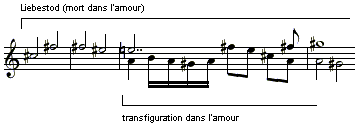Liebestod

"Liebestod" ([ˈliːbəsˌtoːt] German for "love death") is the title of the final, dramatic music from the 1859 opera Tristan und Isolde by Richard Wagner. It is the climactic end of the opera, as Isolde sings over Tristan's dead body.
The music is often used in film and television productions of doomed lovers.[1]
Partial text
|
Mild und leise |
Softly and gently |
References
- ^ "Quoting Tristan: Echoes of Wagner over 150 years of music and film" by Rachel Beaumont, Royal Opera House, 3 December 2014
Further reading
- Bronfen, Elisabeth, Liebestod und Femme fatale. Der Austausch sozialer Energien zwischen Oper, Literatur und Film, Frankfurt am Main: Suhrkamp 2004. ISBN 3-518-12229-0
